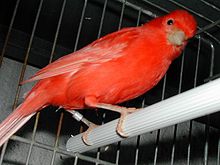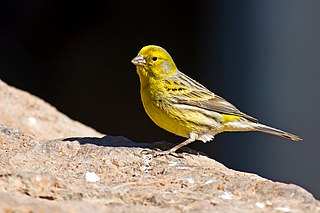
The Atlantic canary, known worldwide simply as the wild canary and also called the island canary, common canary, or canary, is a small passerine bird belonging to the genus Serinus in the finch family, Fringillidae. It is native to the Canary Islands, the Azores, and Madeira. Wild birds are mostly yellow-green, with brownish streaking on the back. The species is common in captivity and a number of colour varieties have been bred.

The budgerigar, also known as the common parakeet, shell parakeet or budgie, is a small, long-tailed, seed-eating parrot. Budgies are the only species in the genus Melopsittacus. Naturally, the species is green and yellow with black, scalloped markings on the nape, back, and wings. Budgies are bred in captivity with colouring of blues, whites, yellows, greys, and even with small crests. Juveniles and chicks are monomorphic, while adults are told apart by their cere colouring, and their behaviour.

The green pheasant, also known as the Japanese green pheasant, is an omnivorous bird native to the Japanese archipelago, to which it is endemic. Some taxonomic authorities consider it a subspecies of the common pheasant, Phasianus colchicus. It is the national bird of Japan.

The white-tailed ptarmigan, also known as the snow quail, is the smallest bird in the grouse family. It is a permanent resident of high altitudes on or above the tree line and is native to Alaska and the mountainous parts of Canada and the western United States. Its plumage is cryptic and varies at different times of the year. In the summer it is speckled in gray, brown and white whereas in winter it is wholly white. At all times of year the wings, belly and tail are white. The white-tailed ptarmigan has a diet of buds, leaves, flowers and seeds. The nest is a simple depression in the ground in which up to eight eggs are laid. After hatching, the chicks soon leave the nest. At first they eat insects but later move on to an adult diet, their mother using vocalisations to help them find suitable plant food. The population seems to be stable and the IUCN lists this species as being of "Least Concern".

The blue-crowned hanging parrot is a parrot species endemic to southern Burma and Thailand, Malaya, Singapore, and Indonesia. These parrots are 12cm in height and weight 28g and have a longevity of 14 years. They are recognized by their green plumage, black beak and characteristic blue feathers arranged like a crown on their head.
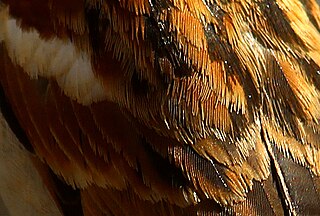
Plumage is a layer of feathers that covers a bird and the pattern, colour, and arrangement of those feathers. The pattern and colours of plumage differ between species and subspecies and may vary with age classes. Within species, there can be different colour morphs. The placement of feathers on a bird is not haphazard, but rather emerge in organized, overlapping rows and groups, and these feather tracts are known by standardized names.

The blue-fronted amazon, also called the blue-fronted parrot, the turquoise-fronted amazon and the turquoise-fronted parrot, is a South American species of amazon parrot and one of the most common amazon parrots kept in captivity as a pet or companion parrot. Its common name is derived from the distinctive blue/turqoise marking on its head just above its beak.

The red-necked amazon, also known as the red-necked parrot, Dominican blue-faced amazon, lesser Dominican amazon, and jaco parrot or jaco, is an amazon parrot endemic to Dominica.

The domestic pigeon is a pigeon subspecies that was derived from the rock dove or rock pigeon. The rock pigeon is the world's oldest domesticated bird. Mesopotamian cuneiform tablets mention the domestication of pigeons more than 5,000 years ago, as do Egyptian hieroglyphics. Research suggests that domestication of pigeons occurred as early as 10,000 years ago.
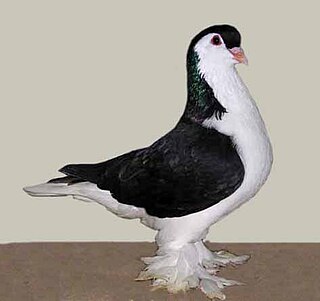
The Lahore is a breed of fancy pigeon known for its impressive size and gentle nature. Lahores, along with other varieties of domesticated pigeons, are all descendants of the rock pigeon.

The domestic canary, often simply known as the canary, is a domesticated form of the wild canary, a small songbird in the finch family originating from the Macaronesian Islands.

The yellow-headed amazon, also known as the yellow-headed parrot and double yellow-headed amazon, is an endangered amazon parrot of Mexico and northern Central America. Measuring 38–43 centimetres (15–17 in) in length, it is a stocky short-tailed green parrot with a yellow head. It prefers to live in mangrove forests or forests near rivers or other bodies of water. It is sometimes considered a subspecies of the yellow-crowned amazon. It is a popular pet and an excellent talker. Poaching for the international pet trade has driven the species to near-extinction in the wild; around half of all wild-caught birds are thought to die in the process.

The Japanese quail, also known as the coturnix quail, is a species of Old World quail found in East Asia. First considered a subspecies of the common quail, it is now considered as a separate species. The Japanese quail has played an active role in the lives of humanity since the 12th century, and continues to play major roles in industry and scientific research. Where it is found, the species is abundant across most of its range. Currently, there are a few true breeding mutations of the Japanese quail. The varieties currently found in the United States include Pharaoh, Italian, Manchurian, Tibetan, Rosetta, along with the following mutations: sex-linked brown, fee, roux, silver, andalusian, blue/blau, white winged pied, progressive pied, albino, calico, sparkly, as well as non-color mutations such as celadon.
The Classic Oriental Frill is an exhibition breed of pigeon from the Owl family. It is a Turkish breed specially bred for the Ottoman Sultans. In its homeland it is known as Hünkari: the bird of the Sultans.
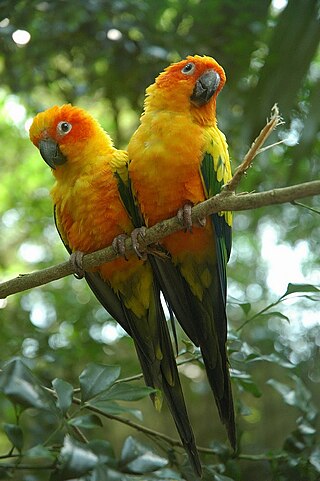
The sun conure, also known as the sun parakeet, is a medium-sized, vibrantly colored parrot native to northeastern South America. The adult male and female are similar in appearance, with black beaks, predominantly golden-yellow plumage, orange-flushed underparts and face, and green and blue-tipped wings and tails. Sun conures are very social birds, typically living in flocks. They form monogamous pairs for reproduction, and nest in palm cavities in the tropics. Sun conures mainly feed on fruits, flowers, berries, blossoms, seeds, nuts, and insects. Conures are commonly bred and kept in aviculture and may live up to 30 years. This species is currently threatened by loss of habitat and trapping for plumage or the pet trade. Sun conures are now listed as endangered by the International Union for Conservation of Nature.

The Buckeye is an American breed of chicken. It was created in Ohio in the late nineteenth century by Nettie Metcalf. The color of its plumage was intended to resemble the color of the seeds of Aesculus glabra, the Ohio Buckeye plant for which the state is called the 'Buckeye State'.

Solid black plumage color refers to a plumage pattern in chickens characterized by a uniform, black color across all feathers. There are chicken breeds where the typical plumage color is black, such as Australorp, Sumatra, White-Faced Black Spanish, Jersey Giant and others. And there are many other breeds having different color varieties, which also have an extended black variety, such as Leghorn, Minorca, Wyandotte, Orpington, Langshan and others.

The Australian plainhead is a breed of domestic canary that was created for show purposes. The variety was developed through selective breeding and remains the only breed of canary created in Australia.

The Catalina macaw, sometimes known as the rainbow macaw is a first generation hybrid between the blue-and-gold macaw and scarlet macaw. As catalina macaws are hybrids, they do not have a true scientific name. The best way to represent these birds in taxonomy is by the expression Ara ararauna × Ara macao.
